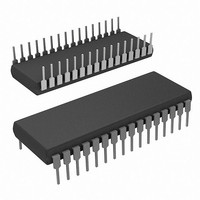STK14C88-3WF35 Cypress Semiconductor Corp, STK14C88-3WF35 Datasheet - Page 7

STK14C88-3WF35
Manufacturer Part Number
STK14C88-3WF35
Description
STK14C88-3WF35
Manufacturer
Cypress Semiconductor Corp
Datasheet
1.STK14C88-3WF35.pdf
(17 pages)
Specifications of STK14C88-3WF35
Format - Memory
RAM
Memory Type
NVSRAM (Non-Volatile SRAM)
Memory Size
256K (32K x 8)
Speed
35ns
Interface
Parallel
Voltage - Supply
4.5 V ~ 5.5 V
Operating Temperature
0°C ~ 70°C
Package / Case
32-DIP (0.600", 15.24mm)
Lead Free Status / RoHS Status
Lead free / RoHS Compliant
Best Practices
nvSRAM products have been used effectively for over 15 years.
While ease-of-use is one of the product’s main system values,
experience gained working with hundreds of applications has
resulted in the following suggestions as best practices:
■
Table 2. Hardware Mode Selection
Document Number: 001-50592 Rev. *A
Notes
1. I/O state assumes OE < V
2. HSB STORE operation occurs only if an SRAM WRITE has been done since the last nonvolatile cycle. After the STORE (if any) completes, the part will go
3. CE and OE LOW and WE HIGH for output behavior.
4. The six consecutive addresses must be in the order listed. WE must be high during all six consecutive CE controlled cycles to enable a nonvolatile cycle.
5. While there are 15 addresses on the STK14C88-3, only the lower 14 are used to control software modes.
The nonvolatile cells in an nvSRAM are programmed on the
test floor during final test and quality assurance. Incoming
inspection routines at customer or contract manufacturer’s
sites, sometimes, reprogram these values. Final NV patterns
are typically repeating patterns of AA, 55, 00, FF, A5, or 5A.
End product’s firmware should not assume an NV array is in a
set programmed state. Routines that check memory content
values to determine first time system configuration and cold or
warm boot status, should always program a unique NV pattern
(for example, a complex 4-byte pattern of 46 E6 49 53 hex or
into standby mode, inhibiting all operations until HSB rises.
CE
H
X
L
L
L
L
IL
WE
H
H
H
X
L
X
. Activation of nonvolatile cycles does not depend on state of OE.
HSB
H
H
H
H
H
L
A
0x31C7
0x3C1F
0x0FC0
0x31C7
0x3C1F
0x0C63
0x0E38
0x03E0
0x303F
0x0E38
0x03E0
0x303F
13
X
X
X
X
– A
0
■
more random bytes) as part of the final system manufacturing
test to ensure these system routines work consistently. Power
up boot firmware routines should rewrite the nvSRAM into the
desired state. While the nvSRAM is shipped in a preset state,
best practice is to again rewrite the nvSRAM into the desired
state as a safeguard against events that might flip the bit
inadvertently (program bugs or incoming inspection routines).
The V
and a maximum value size. Best practice is to meet this
requirement and not exceed the max V
higher inrush currents may reduce the reliability of the internal
pass transistor. Customers who want to use a larger V
to ensure there is extra store charge should discuss their V
size selection with Cypress to understand any impact on the
V
Nonvolatile RECALL
Nonvolatile STORE
CAP
Nonvolatile Store
Not Selected
Read SRAM
Write SRAM
Read SRAM
Read SRAM
Read SRAM
Read SRAM
Read SRAM
Read SRAM
Read SRAM
Read SRAM
Read SRAM
Read SRAM
CAP
voltage level at the end of a t
Mode
value specified in this data sheet includes a minimum
Output High Z
Output High Z
Output Data
Output Data
Output Data
Output Data
Output Data
Output Data
Output Data
Output Data
Output Data
Output Data
Output Data
Output Data
Output Data
Input Data
I/O
RECALL
CAP
STK14C88-3
Active
Active
period.
value because the
Standby
Active
Power
Active
I
CC2
[1, 3, 4, 5]
[1, 3, 4, 5]
Page 7 of 17
[2]
[1]
CAP
value
CAP
[+] Feedback
[+] Feedback
[+] Feedback













